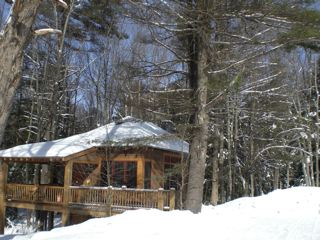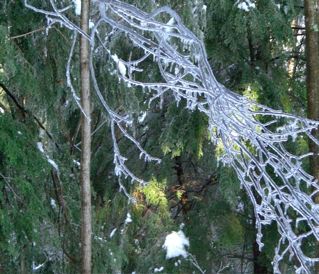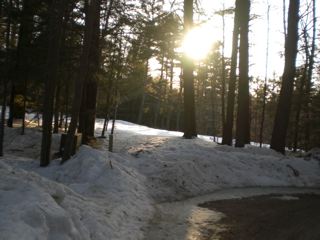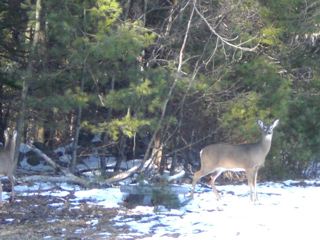|
Samantha Ellis' Play Journal :: fourth instalment
14 February 2008 - 25 May 2008
Samantha records her two-month stay at the MacDowell Colony for artists. She compares the American view of nature with the British view, introduces a tree-sitter into another new play, and tries to survive one of the snowiest winters in New England.
::
14 February 2008
I’m writing this a couple of days into a two-month artists’ residency at the MacDowell Colony in snowy New Hampshire. There are 30-odd studios scattered about 450 acres of woodland—all silvery birches and sticky, feathery pines.

My log cabin studio | Mine is one of the oldest, a log cabin dating back to 1907, its outer walls faced in hemlock bark, its interior smelling powerfully of woodsmoke. The 'tombstones' ranged along one wall are scrawled with the names of all the artists who have ever come to this studio. The oldest ones are smoke-blackened, the names illegible. Jonathan Franzen was here, as was Mary Gaitskill. It’s unbelievably quiet here. At noon, a picnic basket arrives surreptitiously at the door. I see no one until 6.30 when the artists—not just writers but painters, sculptors, video artists, memoirists, composers, printmakers and more—meet for dinner at the white pillared Colony Hall.
It’s deep midwinter. Last night we had a snowstorm, then an ice storm and what the Americans called a 'power outage' after branches and whole trees snapped under the weight of ice and snow. I lit a fire and kept it going for a while but then the light started to fail (late though-we’re on the same latitude as Rome here, which means 12 hours of light a day; if only London winters were like this) and I strapped ice grippers onto my snowboots, switched on my torch and tramped through the woods to the hall where I found a novelist and a composer building a huge fire.
We lit Victorian oil lamps to have dinner by and huddled round the hearth until the power came back on. Late at night, back in my studio, I curled up in bed to read King Lear and shivered as I heard what was unmistakably howling. I woke to find tracks circling my studio. Apparently, though, they are more likely to be coyotes rather than wolves.
Bears, though, are a worry. They are waking up earlier and earlier and this is bear country. When I try to find out about them, the other artists (who are all Americans) laugh. Americans are more relaxed about wildness than we are. Finally I find out that a bear hasn’t been seen at the Colony for years. Just in case, a poet from Washington teaches me a rhyme for what to do in case I do see a bear: 'Bear brown, lie down
Bear black, fight back.'
But how would I go about fighting a bear?
23 February 2008
After finishing The Last Wolf in Scotland (which is being read by producing theatres so watch this space), I started writing a play about an obscure controversy in Orthodox Jewish law, but before I knew it, a tree-sitter character had entered the play and the second half had shifted from a kitchen to a wood which is due to be bulldozed.
There is precedent for my Orthodox Jewish characters going to a wood to find themselves. Isaac Babel, protesting at his cramped childhood of Talmud study, wrote 'In my childhood…I led the life of a sage; later, when I was older, I began to climb trees.'
The Talmud is conflicted about nature-worship. One sage states that 'One who walks on the road while studying a Torah lesson but interrupts to exclaim, "How beautiful is this tree!"—scripture regards him as though he is no longer worthy of living'. But the Talmud also speaks of trees that sing and weep, and of each tree having an angel in heaven telling it "Grow!". Judaism also has Tu b’shevat, a 'new year for trees'. According to Johanan ben Zakkai, another Talmud sage who was Jesus’ contemporary, if you are planting a tree and someone comes to tell you that the messiah has come, you should finish planting the tree and then go and greet him. In London, I talked to tree-sitters who were veterans of campaigns like the one against the Newbury Bypass. Now I’m writing the play in the middle of a wood and while I’m not sure I’d have the nerve to lock-on to a tree like the protestors in the excellent Copse, The Cartoon Book of Tree Protesting I certainly feel more personally about the trees than I did. Here, they almost always anthropomorphise branches as 'limbs' and when photographer Francesca Woodman had a residency here, she photographed herself among the silver birches, wrapping her arms in flaked-off birch bark as though to become a tree herself.
3 March 2008
This piece suggests that beavers will soon be back in Scotland, but there’s still a long way to go. According to the Scottish Wildlife Trust's consultation report, 73 per cent of people in mid-Argyll want beavers back. I’d imagine that a somewhat lower percentage of the Scottish population would come out in favour of wolves.
19 March 2008

Wintry ice storm | The local shoe shop wants us to 'Get ready for mud season!' but the snow’s not melting just yet. It was minus 12 celsius yesterday and on the short walk to breakfast, my damp hair froze in ringlets stiff as plastic.
23 March 2008
Wolf biologists usually howl to find out where the wolves are, but now they won’t have to. The Howlbox sends out a digital howl then analyses the howls that come back so that the wolves can be counted and tracked. Wolf biologists might need it in Montana, Wyoming and Idaho where federal protection for the wolves reintroduced in 1995 is about to end. Once wolves lose their endangered species status, state legislatures will decide how many to kill, and these legislatures are being heavily lobbied by sportsmen eager to go wolf-hunting. Last year, Idaho’s governor, C.L. 'Butch' Otter assured a rally of petitioning sportsmen "I’m prepared to bid for that first ticket to shoot a wolf myself."
29 March 2008
I was startled by wild turkey tracks today—huge and prehistoric-looking arrows in the snow. In lieu of seeing actual wild turkeys, I’ve had to content myself with the very fat grouse. In the mornings you can hear the rattle of the males beating their wings against their chests, along with the woodpeckers determinedly going at the pines.

The woods of New Hampshire | It continues to snow. Some say it’s the snowiest winter since 1898, some since 1874. Either way, we passed the 100-inch mark some weeks ago.
2 April 2008
It’s strange to think that I’ve been living in the shadow of one of the key sites in American eco-criticism. The artists’ colony is shadowed by Mount Monadnock, not only the most-climbed mountain in the world but one of Henry David Thoreau’s favourite climbs. Its name comes from an Abenaki word for 'mountain'. Talk to anybody here—the artists, the maintenance team, anyone—and Native American lore and language comes up sooner rather than later. The American nature writing I’ve read, too, seems pervaded by a sort of longing for the Native American connection with the land, in contrast to British nature writing where we don’t have the same sense of being latecomers to the landscape.
In Britain, though, we do have a long way to go in making our countryside feel accessible to those not born there. Go for a walk somewhere wild in Britain and you rarely hear an accent that isn’t English. The British landscape sometimes feels closed to those who aren’t connected to it by history or blood. Historian Patrick Wright has even speculated that 'the English landscape might be a racist construct.' Certainly, the defensiveness towards American grey squirrels, Alaskan sitka spruces, Japanese sika deer, anything that isn’t thatched does veer towards xenophobia. Our eco-literature, too, rarely comes from anyone who doesn’t have an historical connection to the place they are writing about. But I’m hoping that will change, and is changing.

A deer in the woods | With only a week left here, I’m doing a lot of walking, taking photographs and gathering my thoughts. The Native American adage I’ve most often heard quoted here is that it’s not the noise you make with your feet that stops you seeing or hearing things but the noise in your head. I tried to be very quiet today, and managed to get closer than ever to some deer. 17 April 2008
Last night, Paul Lister who is trying to bring back wolves and other beasties to his Highlands estate was profiled on the BBC. The programme-makers resisted the temptation to call it 'Moose on the Loose', going for the less sensational 'Moose in the Glen', presumably because he plans to enclose the moose (and, if all goes to plan, wolves, bears, etc.) within a perimeter fence.
25 May 2008
The beavers are coming back! The beaver has always been the front line of reintroductions in Scotland. Several conservationists have made the point to me that there is no hope for reintroducing wolves or bears when even beavers aren’t being let back in. But now this is changing. The Scottish Environment Minister Michael Russell has said 'Yes' to a trial reintroduction of 16-20 beavers to Argyll. The beavers, which will be caught in Norway this autumn, put in quarantine and released next spring, will be the first in Scotland in 400 years. They were originally killed for their soft, waterproof furs, for an oil they secrete, castoreum, which was used to make medicines and to enhance sexual potency, for their glands which were used as currency and because they were classed by the medieval church as fish rather than meat and so could be eaten over Lent. Talking to the Sunday Herald, Russell cast the plan in oddly moral language: 'Beavers were an original victim of wildlife crime when they were exterminated and it’s time to rectify that.' The comments on the piece (those which were not just puerile jokes) were mostly hostile. 'Sarah from Ontario' wrote: 'There are not enough trees in Scotland to satisfy the beavers.' Another wrote: 'Scotland must be prepared to pay the cost of repairing roads which will be flooded, property damage, etc.' To this, 'BM Glasgow' responded: 'You obviously have not been here and seen the millions of ugly non-native conifers poisoning the Highlands. They can eat all these as far as I care.' And 'Angus Macmillan' shot back with 'But non-native conifers are fast growing timber that can offset environmentally damaging imports. Better they eat the politically correct native rubbish that is planted by woodland charities first.' Others pointed out that the beavers would benefit the landscape, by moving water around. I like the way beaver expert Derek Gow put it when he spoke at the 'Scary or What' conference: “Beavers water the world."
Samantha Ellis
return to the first instalments of Samatha Ellis' Play Journal
|
return to the first instalments of Samatha Ellis' Play Journal
|